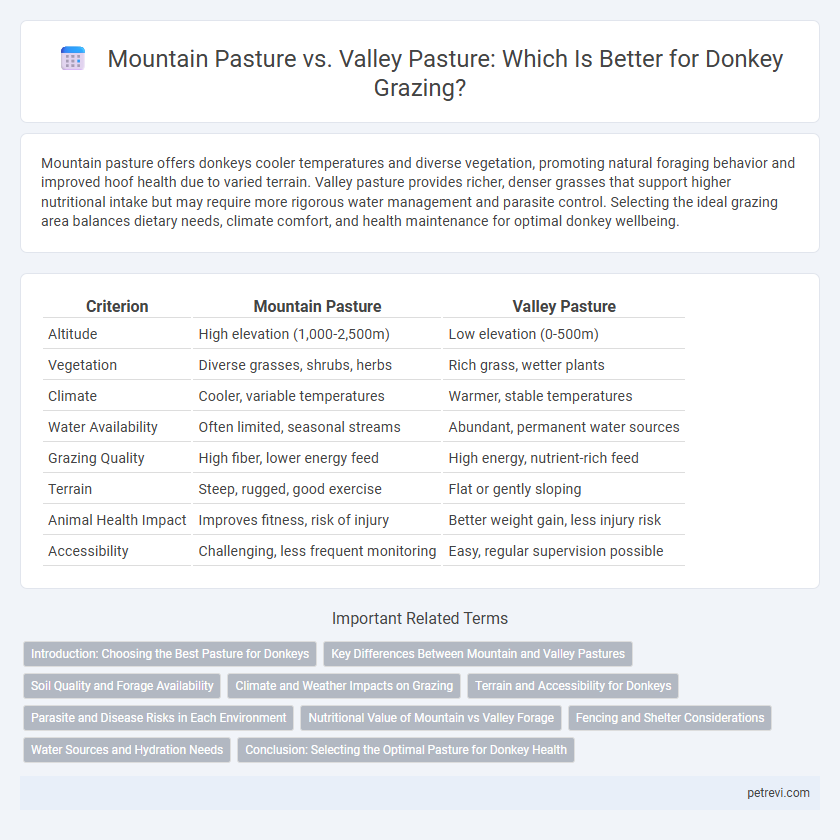Mountain pasture offers donkeys cooler temperatures and diverse vegetation, promoting natural foraging behavior and improved hoof health due to varied terrain. Valley pasture provides richer, denser grasses that support higher nutritional intake but may require more rigorous water management and parasite control. Selecting the ideal grazing area balances dietary needs, climate comfort, and health maintenance for optimal donkey wellbeing.
Table of Comparison
| Criterion | Mountain Pasture | Valley Pasture |
|---|---|---|
| Altitude | High elevation (1,000-2,500m) | Low elevation (0-500m) |
| Vegetation | Diverse grasses, shrubs, herbs | Rich grass, wetter plants |
| Climate | Cooler, variable temperatures | Warmer, stable temperatures |
| Water Availability | Often limited, seasonal streams | Abundant, permanent water sources |
| Grazing Quality | High fiber, lower energy feed | High energy, nutrient-rich feed |
| Terrain | Steep, rugged, good exercise | Flat or gently sloping |
| Animal Health Impact | Improves fitness, risk of injury | Better weight gain, less injury risk |
| Accessibility | Challenging, less frequent monitoring | Easy, regular supervision possible |
Introduction: Choosing the Best Pasture for Donkeys
Mountain pastures offer donkeys diverse vegetation and cooler temperatures, promoting natural foraging and improved hoof health. Valley pastures provide abundant water sources and softer terrain, reducing the risk of injury and ensuring consistent nutrition. Evaluating these environmental factors helps optimize donkey grazing for health and productivity.
Key Differences Between Mountain and Valley Pastures
Mountain pastures offer donkeys diverse, nutrient-rich grasses suited for their robust digestive systems, while valley pastures typically provide softer, more abundant forage but with a higher risk of water-logged terrain affecting hoof health. The rugged terrain of mountain pastures promotes stronger muscle development and endurance in donkeys, contrasting with the relatively flat and accessible valley pastures that facilitate easier grazing but less physical exertion. Temperature fluctuations and wind exposure in mountain areas require donkeys to have thicker coats and greater adaptation skills compared to the milder, more stable climates found in valley settings.
Soil Quality and Forage Availability
Mountain pastures provide donkeys with nutrient-rich, well-drained soils that promote diverse forage availability, including hardy grasses and shrubs suited to steep terrains. Valley pastures typically offer deeper, more fertile soils with abundant moisture, supporting lush, high-yield forage but may be prone to waterlogging and reduced soil aeration. Optimal donkey grazing balances the superior soil quality and varied forage of mountain pastures with the rich, dense vegetation found in valley settings.
Climate and Weather Impacts on Grazing
Mountain pastures provide donkeys with cooler temperatures and increased airflow, reducing heat stress and promoting healthier grazing behavior during hot weather. In contrast, valley pastures tend to have higher humidity and warmer conditions, which can increase the risk of heat exhaustion and decrease forage quality. Seasonal weather variations in mountainous regions often lead to more diverse and nutrient-rich vegetation, enhancing the overall diet and well-being of grazing donkeys.
Terrain and Accessibility for Donkeys
Mountain pastures offer rugged terrain with abundant, diverse vegetation suitable for donkeys adapted to steep, rocky environments, enhancing their agility and foraging skills. Valley pastures provide flatter, more accessible grazing grounds with easier access to water sources and shelter, ideal for donkeys needing consistent nutrition and rest. Accessibility in valleys supports regular donkey movement and care, while mountain terrain challenges their physical endurance and promotes natural behavior.
Parasite and Disease Risks in Each Environment
Mountain pastures offer lower parasite loads due to cooler temperatures and better drainage, reducing the risk of infections like strongylosis in donkeys. Valley pastures often have higher moisture levels and dense vegetation, which increase the prevalence of parasitic larvae such as liver flukes and gastrointestinal nematodes. Effective rotational grazing and regular deworming treatments are essential in both environments to manage parasite burdens and maintain donkey health.
Nutritional Value of Mountain vs Valley Forage
Mountain pasture forage for donkeys typically contains higher levels of fiber and certain minerals like magnesium and calcium due to the diverse alpine plants, promoting better digestive health. Valley pasture vegetation tends to be richer in proteins and energy-dense nutrients, supporting more rapid weight gain and muscle development. Selecting pasture types depends on balancing the donkey's dietary needs, with mountain forage favoring maintenance and valley forage enhancing growth.
Fencing and Shelter Considerations
Mountain pastures for donkey grazing require sturdy, weather-resistant fencing due to uneven terrain and exposure to strong winds, while valley pastures benefit from simpler fencing structures that prevent access to waterlogged areas. Shelter in mountain pastures must provide protection against cold temperatures and sudden weather changes, often necessitating insulated or windproof designs. In contrast, shelter in valley pastures primarily protects from heat and occasional heavy rains, favoring ventilated but shaded structures.
Water Sources and Hydration Needs
Mountain pastures offer abundant natural water sources such as streams and springs, ensuring consistent hydration crucial for donkeys' digestive health and energy levels. Valley pastures may have fewer reliable water points, increasing the risk of dehydration during hot spells due to limited runoff and stagnant water availability. Adequate and clean water access in either terrain remains essential to support optimal donkey grazing and overall well-being.
Conclusion: Selecting the Optimal Pasture for Donkey Health
Mountain pastures offer donkeys higher-quality forage with greater biodiversity, which supports better nutrition and hoof health, while valley pastures provide more consistent water sources and shelter from extreme weather. Optimal donkey health is achieved by balancing the nutrient richness of mountain pastures with the accessibility and safety of valley pastures, ensuring adequate hydration and protection. Selecting a pasture that integrates diverse forage and stable environmental conditions reduces disease risk and promotes overall wellbeing in donkeys.
Mountain Pasture vs Valley Pasture for Donkey Grazing Infographic

 petrevi.com
petrevi.com